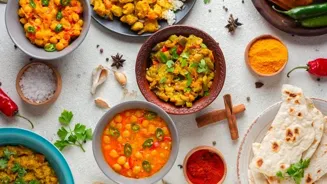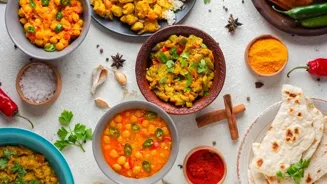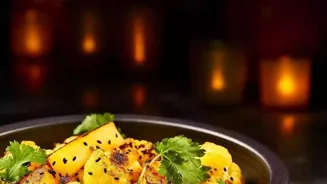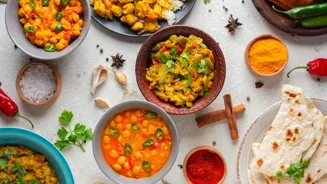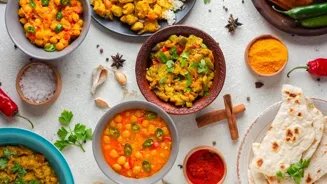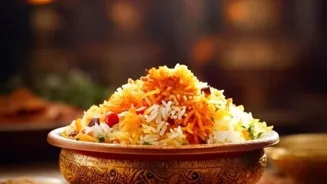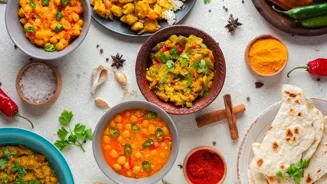Discover the cultural significance of 10 iconic Indian dishes in a culinary journey through India's rich heritage
India, a land of vibrant colours, diverse cultures, and a history that stretches back millennia,
boasts a culinary landscape as rich and varied as its heritage. Food in India is much more than mere sustenance; it's a celebration, a tradition, and an integral part of the social fabric.
Each dish tells a story, reflecting regional influences, historical events, and deeply ingrained customs. Let's embark on a delicious journey to explore ten iconic Indian vegetarian dishes and uncover their fascinating cultural significance.
Dal Makhani: A Legacy of Royal Kitchens
Dal Makhani, a creamy, rich lentil preparation, is a staple in North Indian cuisine. Its roots can be traced back to the royal kitchens of the Mughal era. The dish is traditionally made with black lentils (urad dal) and kidney beans, slow-cooked overnight with butter and cream.
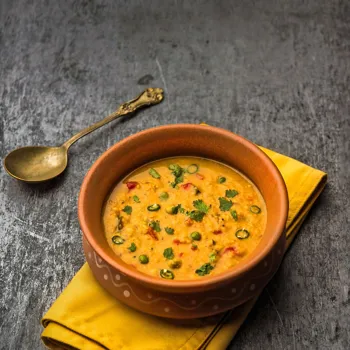
The slow cooking process gives the dal its characteristic smoky flavour and velvety texture. Dal Makhani is often served at special occasions and celebrations, symbolising abundance and prosperity.
The dish represents the grandeur and opulence associated with the royal heritage of India, a reminder of the lavish feasts that were once commonplace in the Mughal courts.
Samosa: A Pocketful of History
The humble samosa, a deep-fried or baked pastry filled with savory potatoes and peas, has a surprising history that spans continents. Its origins are believed to be in the Middle East, where it was known as "samsa.
" The samosa travelled to India along the ancient trade routes and became a popular snack. Over time, it adapted to local tastes and ingredients. Today, the samosa is enjoyed throughout India in various regional variations.
The samosa is more than just a snack; it is a symbol of India's rich history of trade and cultural exchange. The variations in filling and preparation are indicative of how food has evolved in different cultures.
Masala Dosa: A South Indian Delight
Masala Dosa, a crispy, golden-brown crepe made from fermented rice and lentil batter, is a culinary icon of South India. Stuffed with a spiced potato filling, the dish is a testament to the region's ingenious use of simple ingredients.
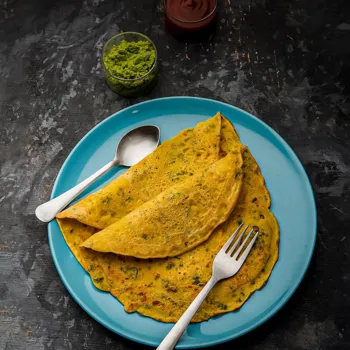
Masala Dosa is thought to have originated in the Udupi region of Karnataka and spread throughout South India. It is often eaten for breakfast or as a light meal and is synonymous with South Indian cuisine.
Masala Dosa showcases the brilliance of South Indian cooking, which uses fermentation to create tasty and nutritious foods. Its popularity speaks to its versatility and timeless appeal.
Chole Bhature: A Punjabi Feast
Chole Bhature is a quintessential Punjabi dish, consisting of spicy chickpea curry (chole) served with deep-fried bread (bhature). This hearty and flavorful combination is a popular choice for breakfast, lunch or dinner in North India.
The dish is known for its rich, tangy, and spicy flavours that explode in every bite. Chole Bhature represents the spirit of Punjab, a land of farmers and warriors. It is often served at festivals and special occasions, symbolising celebration and togetherness.
The dish demonstrates the region's love for robust flavours and generous portions.
Rajma Chawal: A Comforting Classic
Rajma Chawal, a comforting combination of kidney bean curry (rajma) served with rice (chawal), is a staple in North Indian households. This simple yet satisfying dish is known for its earthy flavour and textural contrast.
Rajma, which means kidney bean in Hindi, is believed to have originated in Mexico and was introduced to India through trade routes. Over time, it has become integral to the North Indian diet. Rajma Chawal is more than just a meal; it is a symbol of home and comfort.
It is often prepared for family gatherings and represents the values of simplicity and nourishment.
Idli Sambhar: A South Indian Breakfast Staple
Idli Sambhar is a beloved South Indian breakfast consisting of steamed rice cakes (idli) served with lentil-based vegetable stew (sambhar). This healthy and light dish is nutritious and easily digestible.
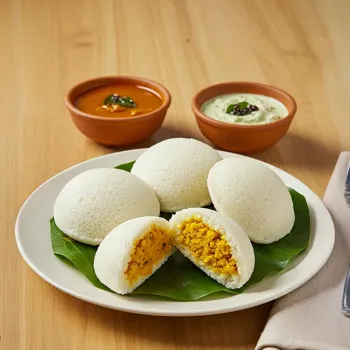
Idli Sambhar is a popular breakfast food found in almost all South Indian states with slight differences in flavor. Sambhar is made with different lentil combinations and vegetables that make it unique. This dish represents the balance of rice cakes and sambhar, it is nutritious and is also tasty.
The dish brings family members to come together for the breakfast meal.
Pav Bhaji: A Mumbai Street Food Sensation
Pav Bhaji, a spicy and tangy vegetable mash (bhaji) served with buttered bread rolls (pav), is synonymous with the bustling streets of Mumbai. This iconic street food is believed to have originated in the textile mills of Mumbai to provide a quick & satisfying meal for the mill workers.
The blend of vegetables and spices makes this dish unique. Pav Bhaji showcases the city's fast-paced lifestyle and love. The dish is perfect for a quick and tasty meal on the go.
Litti Chokha: A Rustic Bihari Delicacy
Litti Chokha, a rustic Bihari dish comprising baked wheat balls (litti) filled with roasted gram flour and served with mashed vegetables (chokha), is a testament to the region's rich culinary heritage. Litti Chokha's tradition originated in Bihar. It provided the travelers with a very filling meal.
The dish is deeply rooted in the region's agrarian traditions. The dish represents the resourcefulness and simplicity of rural life.
Dhokla: A Gujarati Snack
Dhokla, a steamed cake made from fermented batter of rice flour along with split chickpeas (chana dal) is a popular light meal in the state. It is mildly spiced and is served with green chillies, coriander, and grated coconut. This dish represents the culinary ingenuity.
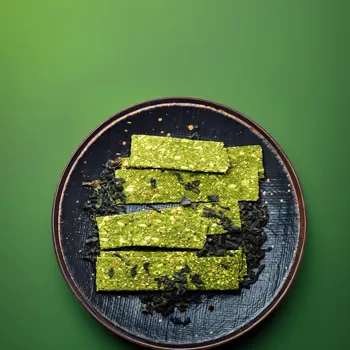
Fermentation is used to create a light snack, and it represents the culinary creativity within the state Gujarat.
Pongal: A Harvest Festival Dish
Pongal, a rice and lentil dish cooked in milk and jaggery, is traditionally prepared during the Pongal harvest festival in Tamil Nadu. The dish symbolises prosperity and gratitude for a bountiful harvest. It is offered to the sun god as a sign of respect.
Pongal showcases the strong connection between food and agriculture in South India.
AI Generated Content. Glance/InMobi shall have no liability for the content